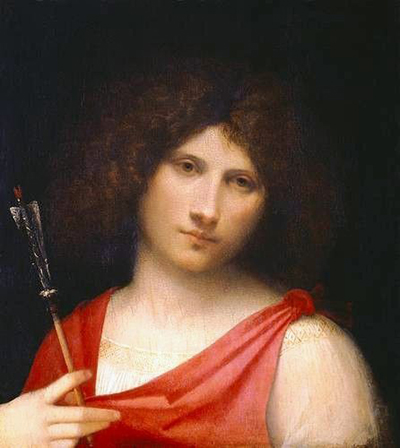Giorgione is famous for the subtle poetic characteristics of his paintings. He is respected as an important artist in the renaissance movement, despite there only being around six remaining paintings confidently attributed to the artist.
The ambiguity surrounding the classification and meaning of his pieces have meant Giorgione has become of the most enigmatic artists in European history. Giorgione's technique used a refined chiaroscuro named sfumato. This method manipulated shades of colour to depict perspective and light, giving Giorgione's art work an enchanted radiance of light which captivates its viewers.
Giorgione's Youth holding an Arrow originally titled Ragazzo con la freccia, is a small painting of only 48 x 42 cm, which is on display at the Kunsthistorsches Museum. It was found in Ambras Castle close to Innsbruck in the year 1663. It was then moved to Vienna in 1773. The painting was attributed to Giorgoine after 1955 and is estimated to have been painted between 1506 and 1508.
Youth holding an Arrow is shrouded in mystery, and there several different interpretations. While the date and artist attribution are agreed upon, some art historians are not satisfied with the title. Assigning a title has proved problematic, as the subject of the painting remains contentious. The figure has been identified as figures from classical mythology or Christian iconography including St. Sebastian, Eros, and Apollo. Recent suggestions have also claimed the boy to be called Paris, who grew up to defeat Achilles with his arrow.
This painting depicts an affecting young man, with his head slanted to the side, displaying immobile features and subtle expressions of serenity. His shoulder length hair is curly, dark brown, and parted in the middle. Its colour and texture seem to blend into the background, while the man’s chiselled features appear to glow, because of the surrounding darkness. The modelling and silhouette combine to create an impressive account of the Renaissance man.
The portrait shows the young man from the shoulders up, he is dressed in a bold red tunic and a white undergarment with delicate trimmings. In his right hand, he is holding the rear of an arrow close to the fletching feathers. The man's index and middle fingers are stretched open, forming a wide grip across the shaft of the arrow. These features make it possible to assume the man is Saint Sebastian. The man is recognisable as the same youth as in Garzone with flute and David with the Head of Goliath, which Giorgione also created.




